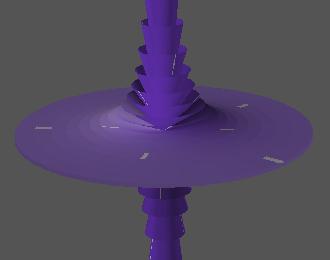NOTE
Here are the schedules for TWIGS Fall 2002,
TWIGS Spring 2003, and
TWIGS Fall 2003.
Spring Schedule
| |  |
20 February |
Farshid Hajir,
UMass Amherst |
| |
1:30-2:30
|
What Is The Riemann Hypothesis?
|
| |
|
| |  |
27 February |
Richard Ellis,
UMass Amherst |
| |
1:30-2:30
|
What Is Stirling's Formula?, or
The Birthday Problem, Stirling's Formula, and Ludwig Boltzmann's
Calculation That Revolutionized Our Understanding of the Universe
|
| |
|
| |  |
5 March |
David Cox,
Amherst College |
| |
2:45-3:45
|
What Is A Groebner Basis?
|
| |
|
| |  |
12 March |
Farshid Hajir,
UMass Amherst |
| |
1:30-2:30
|
What Are the Weil Conjectures?
|
| |
|
| |  |
26 March |
John Fogarty,
UMass Amherst |
| |
1:30-2:30
|
What Is A Differential?
|
| |
|
| |  |
6 April (TUESDAY!) |
Keith Conrad,
University of Connecticut, Storrs |
| |
1:30-2:30
|
What Is A Frobenius Element? [ Note Special Day and Time!]
|
| |
|
| |  |
9 April |
Jessica Sidman,
Mt Holyoke |
| |
1:30-2:30
|
What Is A Sheaf?
|
| |
|
| |  |
23 April |
Arunas Rudvalis,
UMass Amherst |
| |
1:30-2:30
|
What Is A Simple Group of Lie Type?
|
| |
|
| |  |
30 April |
Arunas Rudvalis,
UMass Amherst |
| |
1:30-2:30
|
What Is A Sporadic Simple Group?
|
| |
|
Abstracts
20 February
Farshid Hajir, UMass Amherst
What Is The Riemann Hypothesis?
Abstract
In 1859, Riemann wrote that it was very likely that all zeros in a
certain "critical strip" of the complex plane of a certain function
Zeta(s) previously studied by Euler, Dirichlet and others for real s, lie
on a straight line. This "Riemann Hypothesis" is (among) the most
celebrated conjecture(s) in mathematics. I'll define the Riemann Zeta
Function and some of its generalizations/analogues, describe their basic
properties (some known, some conjectured), and attempt to explain why the
problem plays a central role in certain parts of mathematics.
27 February
Richard Ellis, UMass Amherst
What Is Stirling's Formula?, or
The Birthday Problem, Stirling's Formula, and Ludwig Boltzmann's
Calculation That Revolutionized Our Understanding of the Universe
Abstract
Stirling's formula is an extremely useful approximation to the
factorial function having numerous applications. In this talk two
applications are highlighted.
The first is to the birthday problem. Given a group of n people
chosen at random, let p(n) denote the probability that at least two
people have a birthday on the same day. The problem is to determine
the minimum value of n such that p(n) exceeds 1/2. Stirling's formula
provides an easy approximation to p(n) that in the range of values
considered is accurate to 4 decimal places.
The second application is to a much more profound calculation,
which underlies the use of statistical mechanics and probability
theory to analyze systems consisting of large numbers of particles.
As discovered by Boltzmann in 1877 by applying Stirling's formula, the
asymptotic behavior of multinomial probabilities is expressed in terms
of the relative entropy. The crucial physical implications of this
calculation will be explained.
TOP
12 March
Farshid Hajir, UMass Amherst
What Are the Weil Conjectures?
Abstract
In the 1930's, a hot topic in the intersection of number theory and
algebraic geometry (counting points on curves over finite fields)
blossomed in the hands of Artin, Schmidt, Hasse, Davenport, and Weil to
name a few. While at the University of Chicago, Weil worked out a series
of conjectures (and an ingenious plan for proving them) concerning
extensions of known results from curves to higher dimensional varieties.
These conjectures gave a clear direction and impetus to a revolution in
algebraic geometry spearheaded by Grothendieck. I'll describe the
conjectures, but will be able to say only very little about how Dwork (the
first conjecture) and Deligne (all) resolved them.
26 March
John Fogarty, UMass Amherst
What Is A Differential?
Abstract
We tell our calculus students that 'dx' is a necessay and notationally
useful appendage to integrals, but rarely do we tell them what 'dx'
actually is. Even though integrals do not (yet) exist over fields other
than R or C, one can in fact give a rigorous defintion over any field, via
the 'easier' notion of vector field: namely, we define differentials as
their dual or 'covector fields'. After defining 'Riemann surface'
(algebraic curves of complex dimension 1), we'll look at the role of
differentials as complex coordinates for curves of genus > 1. In the
process, we'll state (but not prove!) the Riemann-Roch Theorem.
06 April
Keith Conrad, UConn Storrs
What Is A Frobenius Element?
Abstract
Galois theory tells us how to associate finite groups to field
extensions, with a nice correspondence between subgroups of the group
and intermediate fields. Frobenius discovered a more subtle
correspondence when the bottom field is the rational numbers: it is
possible to associate to each prime number (with a few exceptions) a
conjugacy class in the Galois group. In particular, when the Galois
group is abelian, so conjugacy classes have size 1, this
correspondence turns prime numbers into individual elements of the
Galois group. For example, when K = Q(i), the
Frobenius element of 3 in the Galois group of K over Q
is complex conjugation and the Frobenius element of 5 is the identity.
(The Frobenius element of 2 in this example is not defined.)
After describing what a Frobenius element (or more generally, a
Frobenius conjugacy class) is, we will explain how they can be used to
give a "non-abelian" generalization of Dirichlet's theorem on primes
in arithmetic progression.
09 April
Jessica Sidman, Mt. Holyoke
What Is A Sheaf?
Abstract
The language of sheaves is an integral part of modern algebraic
geometry. I'll introduce the notion of a sheaf from an analytic
perspective and try to give an idea of how sheaves are used in practice.
23 April
Arunas Rudvalis
What Is A Simple Group of Lie Type?
Abstract
Finite simple groups are among the most interesting objects in
algebra. Abelian simple groups are simple to construct; non-abelian
ones are not! In this talk, we will talk about one important class of
such constructions.
30 April
Arunas Rudvalis
What Is A Sporadic Simple Group?
Abstract
Some simple groups occur in (infinite) families.
Others don't; the latter
are called sporadic. The classification theorem of finite simple
groups lists a number of families of finite simple groups and
gives an explicit list of 26 sporadic ones, namely,
M11,
M12,
M22,
M23,
M24,
HS,
McL,
Co3,
Co2,
Co1,
J2,
Suz,
Fi22,
Fi23,
Fi24',
He,
HN,
Th,
B,
M,
J1,
O'N,
Ly,
J3,
J4
Ru,
2F4(2)'. Every finite simple group either
occurs in one of the known infinite families (discussed
last week) or is one of the sporadic ones just listed.
The picture above was created by
Paul Gunnells.
It visualizes the natural action of the group
of units of a complex cubic field on 3-space.
Consult
Paul for more details.
Last modified: Feb 2004 by
Farshid Hajir


 The Seminar meets on most Fridays, 1:30-2:30
in 1634 LGRT.
The Seminar meets on most Fridays, 1:30-2:30
in 1634 LGRT.
 Driving Directions and
Campus Maps
Driving Directions and
Campus Maps
 Overview of the Seminar
Overview of the Seminar
